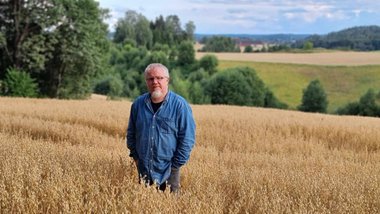The Zaborovsky code
Every day, thousands of people admire the Lavra and Sophia bell towers, the St. Andrew’s Church which rise up on the right bank of the Dnieper. However, the name of the person thanks to whom these and other hallmarks of Kyiv exist, I mean Metropolitan Raphael Zaborovsky, is not mentioned that often.
HISTORY OF OUR SPIRITUALITY
Metropolitan of Kyiv, Halych, and All of Little Russia Raphael Zaborovsky died on October 22, 270 years ago. To mark that date, the National Sanctuary Sophia of Kyiv hosted an exhibition called “MIRA RES...” (Latin for Miracles). One of its key tasks, according to the sanctuary’s director-general Nelia Kukovalska, is to provide a reminder of the history of our spirituality.
“The question of choosing a name for the exhibition reflected how we commemorate Zaborovsky in general. When we proposed to name it ‘MIRA RES...’, the counterargument was that people would not understand what the exhibition is about. However, were one to inscribe on a poster ‘The exhibition is dedicated to the memory of Raphael Zaborovsky’ and go to Sofiiska Square, no more than one individual, perhaps, will answer who he was. And they will be an employee of the sanctuary who went out to have a coffee,” said Ihor Netudykhatkin, a researcher at the Sophia of Kyiv.
However, this was not always the case. In the metropolitan’s lifetime, the school which he helped decided to change the name to the Mohyla-Zaborovsky Academy. And the time when he was the metropolitan is sometimes called “the age of Zaborovsky Baroque.”
“PUZZLES” THAT RESTORE MEMORY
At the exhibition, one can see the models of the Zaborovsky Gate and the Old Academic Building, them being only a few of the large number of buildings the construction of which involved the metropolitan. Also, the Metropolitan Mansion itself, in which the exhibition is held, was completed during Zaborovsky’s reign. In addition, the exhibition has put on display a lot of icons.
According to Netudykhatkin, such love of architecture and iconography was not accidental for Zaborovsky. He says the metropolitan also dabbled in these arts. As the proof of this, he cited Empress Anna of Russia presenting Zaborovsky with an architect’s toolset in 1739.
The photo of the Sophia iconostasis, which is displayed at the exhibition, points to another fact from the metropolitan’s biography. He often spent his own money in support of the Orthodox Church in general and Sophia of Kyiv in particular. It was his money, for example, that funded the Church of St. Volodymyr in the capital’s Shuliavka neighborhood.
One of the most notable exhibits is an 18th-century ship model. Its maker Vadym Hoshko, a representative of the Federation of Ship-Modeling and Ship-Modeling Sports of Ukraine, won 14 medals for his work. This item hints at an interesting period in the life of the metropolitan, when he served as the Ober-Hieromonk of the Imperial Russian Navy.
However, the most important items are in the next room. These are the elements of the metropolitan’s liturgical vestments (miter, omophorion, cuffs), which were discovered by archaeologists as they opened his tomb at St. Sophia Cathedral in 1936. By the way, the cuffs have recently been restored, as have the heads of angels from the burial place of Zaborovsky, which can also be seen at the exhibition.
“A TRUE LIGHT”
As the organizers of the exhibition noted, the name “MIRA RES...” not only repeats the words of Metropolitan Serapion Aleksandrovsky, said when he showed the incorrupt relics of Zaborovsky to the faithful. The activities of the metropolitan were also miracles.
What prompted a man who could Polonize himself and have a career in the Polish-Lithuanian Commonwealth (his native Right-Bank Ukraine was then part of it) to make his way to Kyiv? After all, then the city belonged to another state. Zaborovsky had a fantastic career in the Russian Empire: he became the Ober-Hieromonk of the Russian Imperial Navy in 1723, and Bishop of Pskov and Narva in 1725. Nevertheless, he still cared about the interests of his native land, protecting the existence of the Kyivan Metropolitanate and hindering the Holy Synod’s plans to subordinate the Kyiv Mohyla Academy to itself.
Zaborovsky introduced clear rules not only in church affairs (for example, he forbade priests to let wealthy laymen into the altar), but also in that of the academy, having composed the Academic Rules for Teachers and Students. Under his management, the number of students at the academy doubled, and the city’s architecture was on a rise.
Therefore, all the fields that the metropolitan got involved with experienced a renewal and received an impetus for development. We feel the spiritual pulse of this impetus even today, when, for example, we visit the Sophia of Kyiv. According to Kukovalska, it is hard to speak about the sanctuary without mentioning the name of Zaborovsky.
Therefore, the exhibition “MIRA RES...” is, as director of the Spiritual treasures of Ukraine Museum Ihor Ponamarchuk emphasized, “the first step towards the atonement for our sins, including the fact that we do not remember our heroes.” He also added: “A person does well in the other world as long as we remember them here, commemorate, thank them for being the people they were.”
In the 18th century, a prefect of the Mohyla Academy called Zaborovsky “a true light.” Olha Zarytska, who works for the His Beatitude Metropolitan Volodymyr Memorial Foundation, recalls the words of the Gospel of Matthew that a candle should not be put under a bushel, as it should be put on a candlestick and give light unto people.
“The true light” has been carrying out its mission for a long time. The task of our generation is to create a “candlestick” that will make the knowledge about the metropolitan accessible to the majority. This task is being implemented by the exhibition “MIRA RES...” which will be held at the Sophia of Kyiv until January 24.









